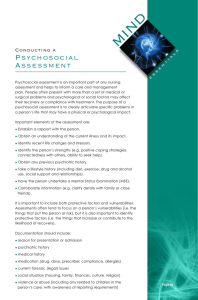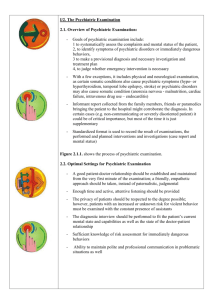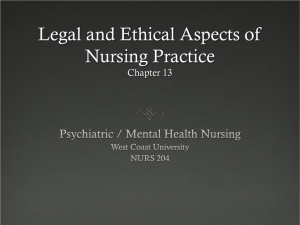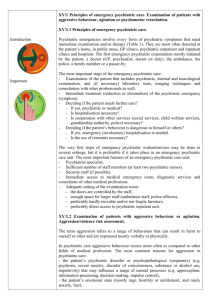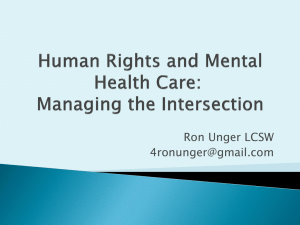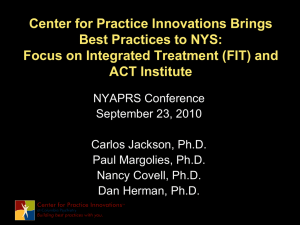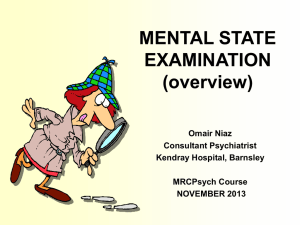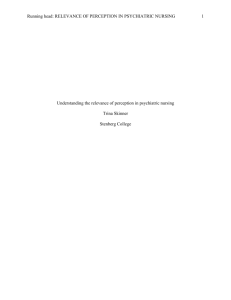Mental Status Examination
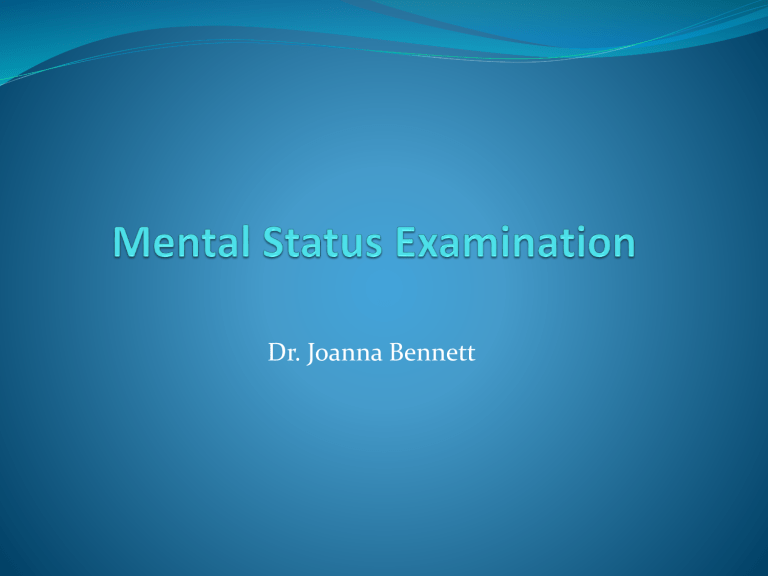
Dr. Joanna Bennett
Psychiatric Nursing Assessment
Central component is the patient/clinical interview
Psychiatric evaluation – Psychiatrist
Psychiatric assessment within nursing process as model of care – nurse
Begins with 1 st contact
Based on establishing rapport/trust – therapeutic relationship
Psychiatric Nursing Assessment
History of present illness
Past psychiatric history
History of substance use
Medical history
Development, psychosocial, socio-cultural
Occupational
Family history
Psychiatric Nursing Assessment
Legal history
Review of systems
Physical examination
Mental Status Examination
Diagnostic tests (psychiatric evaluation)
Clinical formulation
Diagnosis
Care Plan
Mental Status Examination
Mental status examination (MSE) is a core skill of mental health practitioners.
A key part of the initial psychiatric assessment
Entails systematic collection of data based on observation of the patient's behavior while the patient is in the clinician's view during the interview.
Mental Status Examination
The purpose of the MSE:
to obtain evidence of symptoms and signs of mental disorders
danger to self and others
information on the patient's insight, judgment, and capacity for abstract reasoning
Mental Status Examination
Signs and symptoms must be those present at the time of the interview
MSE is used to inform decisions about treatment strategy and an appropriate treatment setting
Mental Status Examination
MSE is conducted in the manner of an informal enquiry
using open and closed questions
structured tests to assess cognition
Information is usually recorded as freeform text using standard headings
Appearance & Behaviour
Includes apparent age, height, weight, and manner of dress and grooming
Body type, Posture, Hair and nails
Colorful or bizarre clothing
unkempt, dirty clothes
signs of malnutrition
needle track marks - drug abuse
Mental Status Examination
MSE is used, together with the psychiatric history, to generate a diagnosis, and a treatment plan.
Appearance & Behaviour
General behaviour
Level of distress
Degree of eye contact
Attitude towards the interviewer
Appearance & Behaviour
“Mr Y presents with good self-care and grooming.
He was courteous and respectful throughout interview”
“Ms X is a 40 year old female looking older than stated age who was disheveled and malodorous at time of interview. She had a stooped posture and maintained poor eye contact”
Motor activity
Level of psychomotor activity
Presence of gait abnormalities
Purposeless, repetitive unusual posture or movement
Tremors, akathisia, dyskinesias
Catatonic posturing
Echopraxia (imitating others movements)
Speech
Rate, Rhythm, Volume, Amount etc.
Poverty of speech
Mutism
Flight of ideas – accelerated with abrupt changes of topic
Pressured speech - rapid, accelerated, frenzied, jumbled and cluttered
http://www.youtube.com/watch?v=9Hpz-
9rwuqA&feature=em-share_video_user
Speech
“ Mr Y’s speech was of normal rate, quality and form”.
Miss X’s speech was pressured and over inclusive when answering
Thought blocking appeared evident during the conversation with John
Mood & Affect
Mood – internal, subjective sustained
Depression, hypomania, dysphoria
Affect – externally observable, changeable
Intensity, stability, appropriateness
Euphoria, anger, sadness
Blunted (reduction) , flat (absence)
Thought processes
Flow of ideas
Vagueness
Incoherence
Circumstantiality – excessive or irrelevant details
Tangentiality – oblique, irrelevant
Word salad – words & phrases lack comprehension
Thought content
What the person is actually thinking (Ideas
& beliefs)
Suicide/homicidal
Delusions (content and effect)
Grandiose
Persecution
Religious
Control
Thought content
“ Mr X described feelings of being followed and being under surveillance. He stated that Digicel had implanted two microchips into his brain through which they could monitor his thoughts. According to Mr X’s Mother he had locked himself in his room for days and would only come out for meals”.
“Mr Y stated that he was Jewish (according to family this is not the case), and that he was going to sail to
Israel to lead the people in the liberation of their homeland.
Perception
Hallucinations perception absence of external stimulus
Any of the senses (Gustatory, Visual, Olfactory, tactile)
Auditory - most common voices
third person - running commentary on the patient’s actions
Second person – talking to the patient
Cognition
Level of Consciousness
Orientation - person, place, time situation
Concentration
Memory
Insight
Awareness of problems and their implications
Recognition of illness and benefits of treatment
Motivation to change - ambivalence to commitment
Judgement
Capacity to make sound, reasoned and responsible decisions
use of standard hypothetical questions
More useful to relate to person’s own selfcare, recent/current situation or behaviour
http://www.youtube.com/watch?v=NVRP9Umpz4M& feature=em-share_video_user
